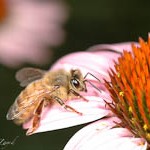Findings show declining bee populations not caused by loss of genetic diversity
TORONTO, May 8, 2012 – A new study by York University researchers debunks the myth that domestication has reduced genetic diversity in commercial honey bees and led to a decline in their numbers.
Previous studies of commercial honey bees have suggested that, as with other livestock, their populations are characterized by low genetic diversity due to domestication. This apparent loss of diversity has been fingered as a cause for declining numbers of bees in North America and Europe, in what scientists have dubbed “Colony Collapse Disorder.”
“This decline in population is of major concern because bees pollinate up to two-thirds of everything we eat, generating roughly $1 billion in Canada annually,” says principal investigator Amro Zayed, assistant professor in York’s Department of Biology, Faculty of Science & Engineering.
However, the jury is still out on whether honey bees are inbred, according to study lead author Brock Harpur, a master’s student in Zayed’s laboratory. “Previous studies compared genetic diversity in European honey bees to African honey bees, but we know that most of our managed bees originated from Europe,” he says.
The study, published in the journal Molecular Ecology, reports that managed honey bee populations established in Canada and France are mixtures of most of the native subspecies of Europe, and that, at a population level, commercial honey bees are more diverse than the European populations from which they are derived. In other words, managed honey bees have more – not less – diversity than their ancestors.
The authors point to the promiscuity of queen honey bees as a cause. “Put simply, we humans can decide on which bees we keep in our yard, but we can’t control the queen bee. She mates as she pleases,” Harpur says.
Zayed explains that queen bees mate on the wing, well away from their colony, with roughly 20 males drawn from a population sourced from every colony in a three to five kilometre radius. “It’s quite extraordinary,” he says. “This means that feral colonies, and the neighbour’s colonies, all contribute to the potential pool of mates, which acts to preserve genetic diversity in managed populations.”
So, if genetic diversity isn’t to blame for the decline of bees, what is?
“Our study shows that reduced genetic diversity is not killing bees – it’s something else. We’ve eliminated one of the major smoking guns,” Zayed says. “We now need to look at other culprits such as new pathogens and pesticides.”
The study’s other authors are master’s student Shermineh Minaei, and postdoctoral research associate Clement Kent, both of York’s Department of Biology. The research was funded by the Natural Sciences and Engineering Research Council of Canada (NSERC).
York University is a leading interdisciplinary research and teaching university in Canada. York offers a modern, academic experience at the undergraduate and graduate level in Toronto – Canada’s most international city. The third largest university in the country, York is host to a dynamic academic community of 55,000 students and 7,000 faculty and staff, as well as 250,000 alumni worldwide. York’s 10 faculties and 28 research centres conduct ambitious, groundbreaking research that is interdisciplinary, cutting across traditional academic boundaries. This distinctive and collaborative approach is preparing students for the future and bringing fresh insights and solutions to real-world challenges. York University is an autonomous, not-for-profit corporation.
-30-
Media Contact: Melissa Hughes, Media Relations, York University, 416-736-2100 ext. 22097, mehughes@yorku.ca


